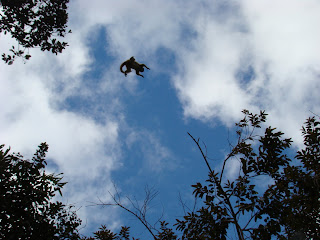Friday, November 30, 2007
Phylial Piety



It’s true. I’m a mammal. And, as such, I recognize that I’ve heretofore been guilty of a somewhat heavy mammalian bias on the site. I don’t know if it’s the fur, the babies, or the binocular vision, but whatever the case, I want here to apologize to all those other phyla (we’re a phylum, right?) that are also deserving of recognition. In Andisibe, for instance, there were many interesting insects and reptiles. Here pictured are some massive green pill-bugs, a bright red millipede, and the world’s largest chameleon. (Stay tuned for the Nosy Mangabe post to see the world’s smallest chameleon!)
(PS - The videos are still going to come some day. But please don't hold your breath. Also, I've dropped the quality (computerwise) of the images a bit. Let me know if the sacrifice in favor of quantity over quality is too much for you.)
Monday, November 26, 2007
Lemuriens!




So now that I’m back in civilization (ie, there are roads and phones, though not steady electricity), it’s high time for some recapping, especially as I’ve yet to post on Madagascar’s most prized inhabitants, the lemurs. My first encounter with these non-monkeys was several weeks ago, in a town half-way between Antananarivo and Toamasina. Just outside the village of Andisibe (pronounced like a dyslexic French child screwing up the start of the alphabet), is a massive national reserve that houses 4 lemur varieties. The main attraction is the Indri (which means “Look up!” in Malagasy), not technically a lemur, in that it’s not in the lemur genus, but still considered such by most. It’s the largest extant “lemur” (there’s evidence of 10-foot lemurs existing 100 years ago, but they seem to have been killed off) and is exceedingly cute. But shockingest of all is its noise, an eerie shriek that can be heard from all corners of the park (and in the video clip). In fact, all lemurs are quite talkative, and some of the noises they make seem utterly alien. They’re also good leapers and eaters, as evidenced here. The other lemurs in the park are the bamboo (not pictured here), the maki (grunting and eating and with baby on back), and the highly endangered golden sikha (with fashionable necklace).
NB:
So, on second thought, this internet is a bit too slow for videos. (Note how I've also been forced to sacrifice some image quality on the golden sikha!) Expect another post including these details soon.
Friday, November 9, 2007
The Life and Death of Great Malagasy Cities




Toamasina. It's already a few days removed from my feet, but not from my heart. A great town. The name is either a reference to St. Thomas, or a comment by the king on tasting the water of the Indian Ocean - "Salty..." The city was a resort on the East coast for the colonial French at the turn of the century, and survived for a while like that until the French were kicked out and people realized that the area gets cyclones on a regular basis. Once the last stop on the Madarail train line, the station (which has seen no action since the late 90s) is now filled with sandbags. Still, the city persists, and still people come to stroll the wide but destroyed streets and view the lavish but crumbling architecture. It's a magical place, one of my favorites so far, and, though since my last post I've camped out with lemurs and swam between islands, I wanted to put the pictures of it online, especially in view of the comment complimenting the cityscape of Antananarivo. Someone needs to set a movie here.
Thursday, November 1, 2007
Antananarivo!




So I think that's the right number of "nana"s. I'm posting now from Madagascar's beautiful, somehow-Mediterranean capital, where the houses wend up through red-dust hillsides and the meat of choice is zebu. I'm only spending a couple days here before heading East, but I've been very happy so far. The markets are flush with people packing in sausages and eating some of the half-dozen mango varieties; the scenery is full of long vistas, with rice paddies and fish farms in the distance; and the history, which involves a great king (named Andrianampoinimerinandriantsimitoviaminandriampanjaka) and a crazy queen (his daughter in law) who threw Christians off of the cliffside (see picture) next to her palace, provides the place with a nice mix of local customs and French influence (croissants!).
First, some baby monkeys



Even though I'm now in Madagascar, I can't help but think of the poor baby monkeys I've left behind in Tanzania. Sorry for the delay in putting these up, particularly those of you who requested monkeys. This baby is a baboon, as opposed to the previous one. The other shot is of a lounging monkey, getting some sun in a treetop. (A few additional points that I don't have time to put up: baby baboons ride on the backs of their moms, which is very cute; if you see one baboon (or 20) it means that many more are hiding in the bushes; and baby giraffe necks are the perfect length for nursing and their frankenstein-antennae are extra fuzzy.)
Subscribe to:
Comments (Atom)